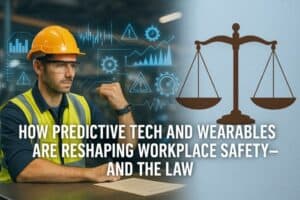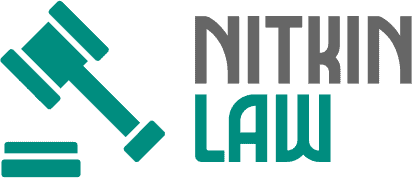
What if workplace accidents could be predicted (and prevented) before they happen? That’s no longer science fiction. With the rise of predictive safety technology and wearable monitoring devices, employers now have access to real-time insights that can detect risks early and reduce harm.
But these innovations aren’t just improving safety. They’re raising new legal questions about responsibility, negligence, and compliance. As technology changes how we protect workers, it’s also quietly redefining the legal standards that govern the modern workplace.
Predictive Safety Technology: From Forecasting to Legal Expectations
Predictive safety technology uses data analytics and machine learning to identify potential risks before they become incidents. These systems analyze patterns such as employee fatigue, repetitive motion, or equipment wear and tear to forecast when and where accidents might occur.
In practice, this means fewer surprises on the floor and more informed decisions about where to direct training, maintenance, or supervision efforts. By catching trends early—like increased slips in a certain zone or repeated misuse of equipment—companies can take targeted action before someone gets hurt.
The legal impact of predictive tech is growing. When tools exist that could reasonably prevent harm, courts may begin to view failure to use them as negligence. If an employer has access to data showing elevated safety risks and doesn’t respond, that inaction can be used as evidence in liability claims. While there’s no universal mandate requiring predictive analytics yet, the use of such technology is already influencing how regulators and courts define a “reasonable” standard of care in high-risk industries.
Are the Laws Keeping Up?
Workplace safety laws have traditionally evolved slowly, often only in response to major accidents or industry lobbying. Today, that reactive model is being tested by fast-moving advancements in safety tech.
Regulatory bodies like OSHA have begun acknowledging the role of predictive systems and wearables but haven’t yet issued clear standards on their use. This gap means companies that lead in safety innovation may be operating in a legal gray area—one where they’re setting expectations that others may eventually be held to.
In many cases, private standards are moving faster than public regulations. Insurers, for instance, are beginning to offer incentives for companies that use predictive analytics and real-time monitoring to reduce claims. Meanwhile, courts are referencing the availability of technology in determining liability.
In cases where an injury occurs and safety innovations were available but not used, a specialized personal injury lawyer may argue that the employer failed to meet a reasonable standard of care. While formal regulations are catching up, the legal risk of ignoring available innovations is becoming real. Companies that wait for official guidance may find themselves out of step not only with best practices but also with evolving interpretations of “due diligence”.
Wearables and Real-Time Monitoring: Safety on the Worker’s Body
Wearable technology has made it possible to monitor workplace safety in real time—directly on the worker. Devices like smart vests, helmets, wristbands, and even boots can track vital signs, movement patterns, exposure to hazardous substances, and even the surrounding temperature. These tools alert both the employee and management when conditions become dangerous, such as overheating or overexertion. It’s not just about high-tech gear. It’s about catching early warning signs before an incident occurs.
From a legal perspective, wearables introduce new responsibilities. If a device alerts management that a worker is at risk and no action is taken, that alert could later become a critical piece of evidence in court. Continuous monitoring may also blur the line between workplace safety and worker privacy.
Employers must balance legal duties to provide a safe environment with compliance around biometric data collection and use. As wearables become more common, legal frameworks are evolving to define how this real-time data should be handled—and what happens when it’s ignored.
When Tech, Data, and Law Intersect
The real potential of safety innovation lies in combining predictive technology with wearable data. Imagine a system that tracks a worker’s heart rate and physical strain, while also analyzing their task history and environmental conditions. If that system flags a high probability of injury, the employer is now armed with the kind of insight that demands a response. Failure to act on that insight—especially if documented—could be seen as a violation of the employer’s duty of care.
This intersection is where safety innovation becomes a legal game changer. Previously, workplace safety was largely reactive—investigating after something goes wrong. But when technology gives you a chance to intervene ahead of time, accountability shifts.
Courts may soon ask not just what employers did after an incident, but what they could have done before it. As these tools become more accessible and affordable, their adoption may start to define the new legal baseline for what a responsible employer looks like.
What Employers Need to Know Now
Employers should start by understanding the technologies available in their industry and what risks they are designed to address. Predictive analytics can help target the most accident-prone zones or workflows, while wearables can provide a real-time view of worker safety. Together, they form a powerful toolkit that helps prevent injuries and demonstrates a proactive approach to workplace safety—something that can be critical in both compliance reviews and legal disputes.
At the same time, adopting these tools comes with new responsibilities. Employers need to create clear policies around how safety data is used, who has access to it, and how they will respond to alerts or trends.
It’s also crucial to consider employee privacy and consent, especially when biometric data is involved. Consulting legal and HR teams before implementing such systems is essential. Being proactive in both safety and compliance isn’t just smart—it’s quickly becoming expected.
Conclusion
What happens when safety tools become so effective that ignoring them becomes a liability? As predictive technologies and wearable devices become more common, they’re not just shaping how companies prevent accidents—they’re influencing how courts and regulators define responsibility.
Employers who embrace these innovations are not only protecting their workers but also aligning with the evolving legal standards that favor proactive safety. Those who delay may find themselves judged not just by what they did, but by what they could have done.

